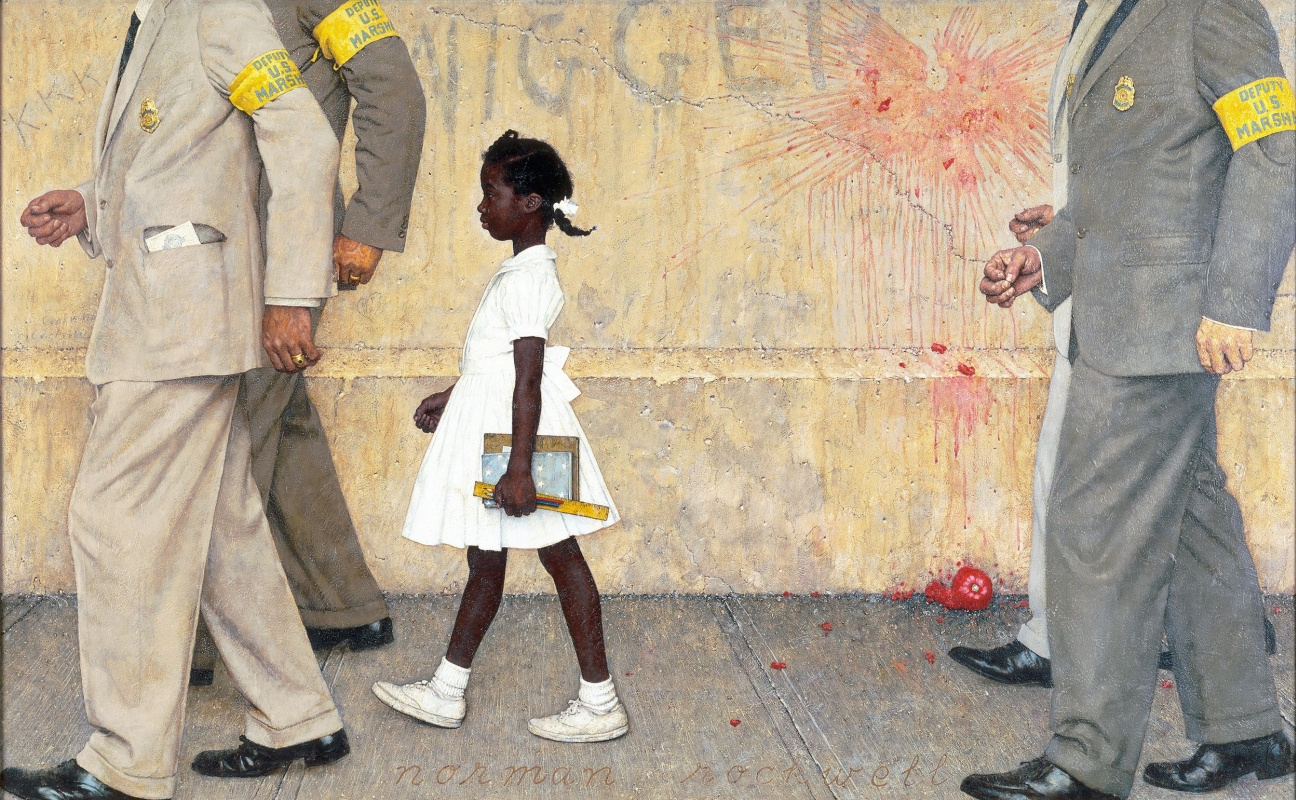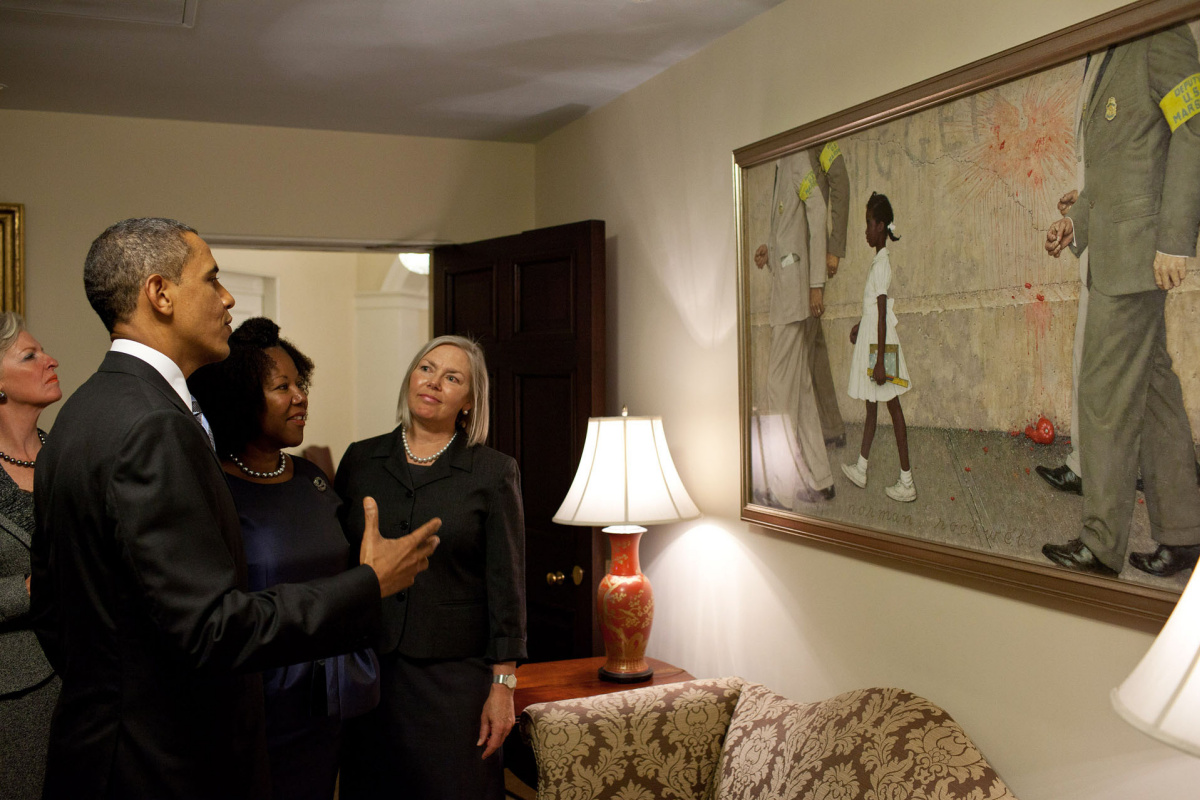log in
Enter site
Login to use Arthive functionality to the maximum
The problem we all live with
Norman Rockwell • Painting, 1964, 91.4×147.3 cm
Description of the artwork «The problem we all live with»
Norman Rockwell's The Problem We All Live With opened a new period in the artist’s work. At this time, Rockwell left his job in The Saturday Evening Post and began to illustrate a more democratic magazine, Look, where the artist could express his attitude to social problems (1, 2).
It was in this magazine that an illustration was published that later became a symbol of the struggle for racial equality. The editors did not dare to place it on the cover (where the artist’s works were usually printed), no American magazine would have done it in the 1960s. Probably, in order to understand the full power, challenge and significance of this famous painting, one would have to be born in America.
In The Problem We All Live With, the artist captures a historic moment: for the first time in the history of the American South, a black girl goes to an all-white school. This happened on 14 November 1960 in New Orleans at the W. Franz Elementary School. It was legal, according to the decision of the Federal Court in 1960, in the United States, laws that divided the population by race were cancelled. However, this event caused a lot of protests and persecution in the city of the Ruby Bridges family, the family of the girl who was sent to study in a general school. Today she is called an American heroine (historical footage with Ruby).
On that day, little Ruby Bridges, approaching the school, did not even realize that an angry crowd had gathered because of her, and the five men who accompanied her to school were her guards. One of the U.S. deputy marshals who accompanied Ruby that day, Charles Barks, recalled: “She showed a lot of courage. She never cried. She didn't whimper. She just marched along like a little soldier, and we're all very very proud of her.”
Many years later, in an interview, Ruby said that the townspeople came and threatened her every day: “There were days when mothers came with a small coffin and put a black doll in it, and at night I had nightmares.” She remained the only black student in her class for a whole year.
Four years after this event, Norman Rockwell painted The Problem We All Live With. The artist constructed the composition in an interesting way: in the centre of the picture, we see a little girl in a white dress that contrasts with her skin colour. She is accompanied by four U.S. marshals in formal suits, the painting is framed such that the marshals’ heads are cropped at the shoulders, we cannot see their faces. Instead of threatening crowd, Rockwell painted a brick wall with a nasty trace of their anger: the racial slur “nigger”, a smashed and splattered tomato thrown against the wall, and the letters “KKK” meaning Ku Klux Klan, a terrorist organization, which defended the idea of the superiority of the white race. The key detail of the painting is the bandages on the sleeves of the men reading “Deputy U.S. Marshal”. The whole essence and meaning of this picture lies in these yellow bands, which mean that the girl is not accompanied just by marshals, she is guarded by the United States of America.
The Problem We All Live With was the first work acquired by the Rockwell Museum in 1975. In honour of the 50th anniversary of school desegregation, in 2011, U.S. President Barack Obama had this painting installed in the White House in a hallway outside the Oval Office and invited Ruby Bridges (photo: whitehouse.gov).
In 1999, Ruby Bridges herself formed Ruby Bridges Foundation, to promote “the values of tolerance, respect, and appreciation of all differences”. Speaking of the painting, in which she became the main character, she expressed deep gratitude to Norman Rockwell for “having the courage to step out of the crowd and say: ‘I want to make a statement’. And he did it in a very powerful way.”
Written by Iryna Olikh
It was in this magazine that an illustration was published that later became a symbol of the struggle for racial equality. The editors did not dare to place it on the cover (where the artist’s works were usually printed), no American magazine would have done it in the 1960s. Probably, in order to understand the full power, challenge and significance of this famous painting, one would have to be born in America.
In The Problem We All Live With, the artist captures a historic moment: for the first time in the history of the American South, a black girl goes to an all-white school. This happened on 14 November 1960 in New Orleans at the W. Franz Elementary School. It was legal, according to the decision of the Federal Court in 1960, in the United States, laws that divided the population by race were cancelled. However, this event caused a lot of protests and persecution in the city of the Ruby Bridges family, the family of the girl who was sent to study in a general school. Today she is called an American heroine (historical footage with Ruby).
On that day, little Ruby Bridges, approaching the school, did not even realize that an angry crowd had gathered because of her, and the five men who accompanied her to school were her guards. One of the U.S. deputy marshals who accompanied Ruby that day, Charles Barks, recalled: “She showed a lot of courage. She never cried. She didn't whimper. She just marched along like a little soldier, and we're all very very proud of her.”
Many years later, in an interview, Ruby said that the townspeople came and threatened her every day: “There were days when mothers came with a small coffin and put a black doll in it, and at night I had nightmares.” She remained the only black student in her class for a whole year.
Four years after this event, Norman Rockwell painted The Problem We All Live With. The artist constructed the composition in an interesting way: in the centre of the picture, we see a little girl in a white dress that contrasts with her skin colour. She is accompanied by four U.S. marshals in formal suits, the painting is framed such that the marshals’ heads are cropped at the shoulders, we cannot see their faces. Instead of threatening crowd, Rockwell painted a brick wall with a nasty trace of their anger: the racial slur “nigger”, a smashed and splattered tomato thrown against the wall, and the letters “KKK” meaning Ku Klux Klan, a terrorist organization, which defended the idea of the superiority of the white race. The key detail of the painting is the bandages on the sleeves of the men reading “Deputy U.S. Marshal”. The whole essence and meaning of this picture lies in these yellow bands, which mean that the girl is not accompanied just by marshals, she is guarded by the United States of America.
The Problem We All Live With was the first work acquired by the Rockwell Museum in 1975. In honour of the 50th anniversary of school desegregation, in 2011, U.S. President Barack Obama had this painting installed in the White House in a hallway outside the Oval Office and invited Ruby Bridges (photo: whitehouse.gov).
In 1999, Ruby Bridges herself formed Ruby Bridges Foundation, to promote “the values of tolerance, respect, and appreciation of all differences”. Speaking of the painting, in which she became the main character, she expressed deep gratitude to Norman Rockwell for “having the courage to step out of the crowd and say: ‘I want to make a statement’. And he did it in a very powerful way.”
Written by Iryna Olikh



